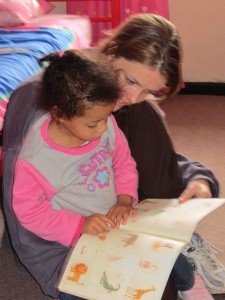 “Read this to me, please!” are the words we all love to hear from our children because they mean that they are interested in stories and books, and are on their way to becoming independent readers. But do you often wonder whether there are ways that you could improve your reading-to times with your children? There are no correct or incorrect ways to share books with a child, but here are some ideas you might like to try:
“Read this to me, please!” are the words we all love to hear from our children because they mean that they are interested in stories and books, and are on their way to becoming independent readers. But do you often wonder whether there are ways that you could improve your reading-to times with your children? There are no correct or incorrect ways to share books with a child, but here are some ideas you might like to try:
Choosing books. If you have lots of books to choose from or are at the library, let your children choose which books they want you to read. If you are helping them to choose books, suggest ones that suit their interests.
Timing is everything. Find a time when your children find it easy to settle. This might be after bath time or just before they go to sleep at nap time and/or at night.
Read together in bite-size chunks. Younger children find it difficult to concentrate for long periods of time or when they are tired. If your children become restless or lose interest, stop reading and try again later or the next day. Remember you want to encourage them to develop an interest in stories and books, so don’t make it a chore!
Babies and books. Children under a year old explore their environment using their senses. They will enjoy story times where they are give opportunities to touch the pages of the book, watch you point to specific things in the simple pictures, hear you sing or say rhymes… and even pat and chew the book a bit!
Don’t skip the cover. Read the title of the book and the name of the author and illustrator each time you read a book to your children. This helps them to realise that real people create stories. If it is the first time you are reading the book with your children, ask them if they can guess what it might be about from listening to the title and looking at the illustration on the cover.
Ask questions. As you read the story, ask your children questions about it. ‘What do you think will happen next?’ is a great question to develop children’s prediction skills, which are very important literacy skills. After you have read each page, ask your child to find different things in the picture.
Read it again! If your children ask you to read a story again… and again and again, do it! This shows them that you respect the choices they make for themselves and it allows them to discover new things about the story each time you read it.
Reading the words together. As your children become more familiar with a story or as older children are learning to read, ask them to help you read the story. Younger children are often able to recite parts of familiar stories – especially if the words rhyme or a phrase is repeated. Let them do this while you point to the words. Read along with older children as they attempt to read the words on the page with you, pointing to the words as you go.
Reading together is for older children too. Once children can read, don’t stop reading to them! Choose books that are more difficult than the ones your children can read on their own. Or, ask your child what has happened in the book she is reading at the moment and then take turns in reading a chapter to each other.

